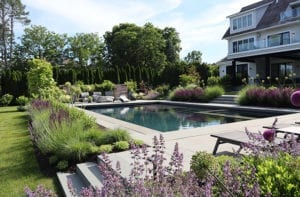Looming Large
February 21, 2011
Text by Nathaniel Reade
In 2008, the interior designer of a big house being built on the coast near San Francisco sent Sam Kasten an eight-inch-by-ten-inch cardboard box. The box contained the specifications for the drapery and upholstery Kasten was to create for the house, the total bill for which was likely to reach tens of thousands of dollars. And what was in the box? Nothing but a pinecone, a sparkly rock, strands of Spanish moss and two chunks of bark, one a deep rust color, the other a light gray with dark, diagonal cracks.
This is one reason why his clients love Sam Kasten, a youthful-looking man with close-cropped brown-gray hair who has been designing and handweaving textile art for about forty years: he can take a miniature natural-history museum in a box and translate it into cloth. Born in Chicago in 1949, Kasten had no interest in weaving until the summer before his senior year at the University of Iowa, when he happened to walk into a weaving shop on Nantucket. He spent the next two weeks of his vacation in that shop, watching people work their handlooms. “Something about it,” he says, “got to me.” Oh yeah.
He went back to college, graduated and got a job at that same Nantucket shop, which happened to be owned by a textile artist who had himself been taught by some of the biggest names of the Bauhaus. A few years later Kasten found himself weaving textiles for such iconic architects as I.M. Pei. He’s still struck by the irony that they wanted to adorn the inside of their sleek, ultra-modern skyscrapers with fabric made on a crotchety old handloom in Nantucket using 1,000-year-old technology.
Kasten eventually moved his family from Nantucket to the Berkshires for its cultural offerings: art, opera, theater. As his business grew he needed more space, so he left his studio in Stockbridge, Massachusetts, for a former parochial school in Pittsfield. The inside of the former Notre Dame Middle School still has the look of a Jimmy Stewart movie—black slate chalkboards, walls of six-foot windows, old varnished doors and maple floors. Right where you expect to see a nun in her black habit brandishing a pointer or a polished apple, however, you see two or three six-foot-wide looms, and Mario Aragon throwing the shuttle across an array of silk and linen threads, then pulling it into place with the beater bar. When he stomps on a pedal to shift the warp threads—this creates the pattern—in the classroom below it sounds as if somebody is moving heavy furniture.
Because Mario is making a fairly simple weave, he’s able to produce a yard or more a day, fifty-two inches wide. With more complicated cloth, he might weave only a foot. And the weaving is the satisfying part: loading the loom with the right threads can take two weeks. This, plus the high quality of the silk, wool and linen thread he uses, explains why Sam Kasten’s fabrics can cost more than $700 a yard, and his rugs more than $100 a square foot.
Which raises the question: Why? Why endure the expense of all that hand labor? Why not use machines?
For one thing, handwoven textiles tend to last longer. With age they develop patina. One of Kasten’s clients raised three kids on and around two sofas covered with Kasten’s silk chenille, and twenty-five years later the upholstery still looks perfect. Handwoven fabrics also tend to have a liveliness and personality that machine-made textiles lack. And when patrons pay for Kasten’s textiles, they get a work of art. So maybe the question itself isn’t fair. Did anyone ever ask Picasso why he used a brush instead of a sprayer?
Most of all, though, Kasten offers clients limitless possibility. He has matched colors from a chip of plaster, the mold on an orange peel and that box of rocks, moss and bark. Kasten and Marsha Altemus, one of his assistants, worked for months to mirror both the colors and textures of the things in that box. They evoked the light and fissures of the gray bark, for instance, by creating a silky, silvery twill with variegated diagonal brown lines, something that’s not easy to achieve in a medium as right-angled as cloth. Another fabric, which eventually became bedspreads, captured the light green of the moss and, thanks to the mohair in the mix, also its fuzziness.
A manufactured line limits your imagination to the colors offered, Kasten points out, forcing people to settle for what might be just okay. “We’re unlimited,” he says with a smile. “We give people their color.”
Sam Kasten Handweaver
Pittsfield, Massachusetts
(413) 236-8800
www.samkasten.com
Share
![NEH-Logo_Black[1] NEH-Logo_Black[1]](https://www.nehomemag.com/wp-content/uploads/2022/08/NEH-Logo_Black1-300x162.jpg)





















You must be logged in to post a comment.